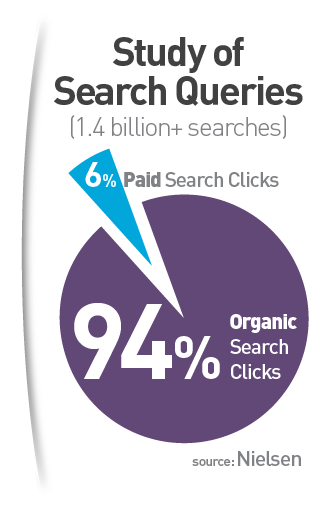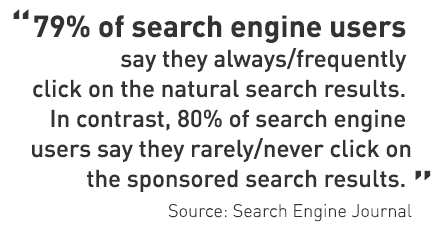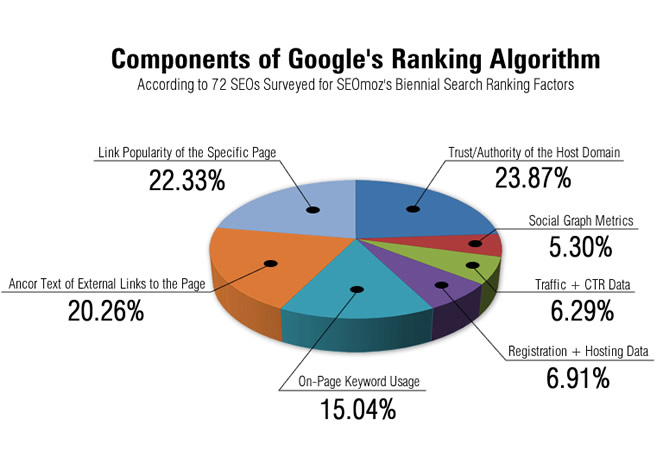Multiple studies and surveys have shown that going after high search-engine visibility is one the most effective things a business can do to connect with qualified, motivated prospects and achieve its marketing goals. But how do you make sure your business is maximizing your search-engine visibility strategy?
There are two primary ways you can be visible for online searches:
-
Paid advertisements. You pay a search engine to be visible for specific keyword searches, and your listing is labeled an advertisement.
-
“Organic” visibility. Your listing is not (and cannot be) purchased. Instead, its ranking position in the main search results area is earned according to how well it meets various search-engine criteria.
 Many people wrongly assume that choosing one or the other – paid search or organic visibility – makes no difference; each is equally good. It’s understandable why. Going after organic visibility takes time and effort, and a lot of businesses don’t think they have the resources. If they can get roughly the same benefits from paid search, why not go that route? There is just one problem with this thinking, and it has to do with data showing how consumers actually use search engines. A recent study by Nielsen took a look at consumer behavior across 1.4 billion search queries. In this study, only 6% of search engine users clicked through on a paid search listing while 94% of them clicked through on an organic result. I have seen numerous other studies on this topic as well, and they sometimes show a click-through rate (CTR) of 30% or higher on paid search listings. But this is the exception, not the rule. Besides that, CTR isn’t the only measure of a listing’s effectiveness.
Many people wrongly assume that choosing one or the other – paid search or organic visibility – makes no difference; each is equally good. It’s understandable why. Going after organic visibility takes time and effort, and a lot of businesses don’t think they have the resources. If they can get roughly the same benefits from paid search, why not go that route? There is just one problem with this thinking, and it has to do with data showing how consumers actually use search engines. A recent study by Nielsen took a look at consumer behavior across 1.4 billion search queries. In this study, only 6% of search engine users clicked through on a paid search listing while 94% of them clicked through on an organic result. I have seen numerous other studies on this topic as well, and they sometimes show a click-through rate (CTR) of 30% or higher on paid search listings. But this is the exception, not the rule. Besides that, CTR isn’t the only measure of a listing’s effectiveness.
 Other studies have shown that about 80% of searchers trust organic results more than paid search ads, which they thus tend to avoid. Regardless of which study you think most relevant, it is impossible to get away from the fact that a large share of marketing opportunity lies in organic search-engine visibility.
Other studies have shown that about 80% of searchers trust organic results more than paid search ads, which they thus tend to avoid. Regardless of which study you think most relevant, it is impossible to get away from the fact that a large share of marketing opportunity lies in organic search-engine visibility.
The truth is, a comprehensive strategy will include an appropriate mix of both organic search engine optimization and paid search strategies. But your spend should be in line with the share of opportunity you want and what you’re likely to get given the specifics of your industry and geographic locations.

Source: ChamberofCommerce.com national survey of local businesses The Challenges of Local Organic Search Engine Visibility
Even though there is significant opportunity in organic search visibility, many businesses fail to pursue it effectively because doing so isn’t as straightforward as going after paid search. Success in organic search visibility requires constantly and consistently addressing factors critical to maximizing your search-engine relevance. That means using the techniques of search-engine optimization (SEO) to ensure that your web content includes topics and search terms relevant to your business. These techniques can be complicated. They change constantly, too. Not only that, but if you don’t use the right techniques or you use them improperly, there is no guarantee that you’ll get the organic search visibility you need. Google considers more than 200 factors when evaluating web pages for placement in its search results, but they fall into the following main categories:

For a more in-depth look at specific search ranking factors take a look at this great resource from Moz.com: http://moz.com/search-ranking-factors.
The sheer amount of study required to understand the myriad ranking factors, let alone the effort required to develop a strategy that takes them all into account, can be overwhelming. For multi-location marketers, the effort is significantly increased if they want to be visible in searches for each of the geographic markets in which they are active. This has caused many marketers to throw up their hands and default to paid search as the only effective way to get search visibility across all of their markets. While such an approach is certainly understandable, it is important to keep in mind that no matter how much money is spent on paid search, businesses that lack solid organic visibility are missing out on the lion’s share of the lucrative search marketing opportunity for their business.
So how can a multi-location business like yours effectively manage organic search visibility across multiple locations without hiring an army of SEO geeks? There is hope! And these few tips provide it:
-
Implement independent local websites: There are several reasons why nothing beats a stand-alone website for organic search-engine visibility. First off, a local website is solely focused on a specific market and the products and services you offer there. So the search engines have a much more specific idea of what you do and where you do it without that information being diluted by competing content and other locations. A stand-alone site can focus on a specific market with multiple geographical terms and important keywords in a way other techniques –placing a location directory on a centralized website, for instance – cannot. Local, single-location businesses that you compete against have a focused stand-alone website, so it’s important that you bring your “A” game to each local market and have stand-alone sites of your own.
-
Use a platform created for managing a network of local websites: If you are serious about getting organic search visibility at the local level, you will be well served to implement a platform that provides the tools that let you manage your efforts efficiently. As a multi-location business you have the advantage of centralized marketing resources that should be leveraged across your network to create a dominant local web presence in each of your markets. A goodmulti-location website management platform should handle all the technical aspects of onsite SEO for you, provide the tools to publish and personalize content to your network, enable content management workflow across locations, and provide good marketing and lead generation performance metrics across all of your websites.
-
Create a strategy for consistently developing quality content: According to Google and other search engines, high-quality content is the key to search-engine visibility. Great content drives many of the search-engine ranking factors and facilitates good links and social interaction. With the right tools you can get multiple people in your organization involved and ensure that content is uniquely tailored to each location.
-
Be active on social media at the local level: Each location should have at least a basic social media presence. Social media can be used to get your message out and facilitate good links back to your content. That will help drive traffic and search ranking.
-
Make sure all of your local listings are correct and consistent: Many websites will place you in a local business listing. The search engines regard such listings as a significant sign of your website’s credibility and authority. Included in most listings is a NAP (name, address, and phone number), which also is called a citation. Other data relevant to your local business may be provided as well, such as your website URL, blog links, social media channels, and so forth. If your listings are consistent across a variety of reputable online sources, search engines have more confidence in your location, and your search result rankings are likely to improve. There are some nice tools to help you identify and manage your listings across the web, such as GetListed.org by Moz and Yext.
 The effort necessary to successfully achieve local organic search visibility is greater than that for managing a paid search campaign. In the end, though, the results will be worth the effort. Not only will you capture a significant amount of opportunity you can’t get through paid search, but you will likely be able to reduce your spend on PPC and other advertising channels. Implementing the right platforms and tools can provide the structure and efficiencies necessary to be successful. A good local website program also will help you improve conversion rates, coordinate local marketing campaigns, and measure marketing performance across multiple locations and marketing channels.
The effort necessary to successfully achieve local organic search visibility is greater than that for managing a paid search campaign. In the end, though, the results will be worth the effort. Not only will you capture a significant amount of opportunity you can’t get through paid search, but you will likely be able to reduce your spend on PPC and other advertising channels. Implementing the right platforms and tools can provide the structure and efficiencies necessary to be successful. A good local website program also will help you improve conversion rates, coordinate local marketing campaigns, and measure marketing performance across multiple locations and marketing channels.
My next blog will show you how you can quantify the revenue opportunity of your organic search-engine visibility. Until then, feel free to connect with me on LinkedIn or Twitter if you have any questions or comments about this blog. And don’t forget to sign up for our free MarketSnare “Capture” newsletter – the resource for local visibility, local opportunity, local relevance.
Featured image “Scales of Justice” by Dan4th

